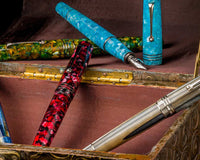When you draw a line in the sand, use a stick. But when drawing a line on paper, choose sides first—pencil vs. pen: which is the superior writing instrument?
Before we enter the fray and dive into the never-ending and often vehement debate about pens. vs. pencils, let’s just take a moment to appreciate that the adversaries in this argument are passionate about writing by hand. If we set the tone that way, perhaps we can have a more genteel debate on the topic, pens vs. pencils: which is the superior instrument?
Anyone who loves pens and defends their superiority as writing implements also uses pencils. Even users of luxury writing pens will reach for pencils when the task calls for them. Those who deride pencils may be stuck on the old-fashioned yellow number 2’s, and may never have experienced the ease, tidiness and convenience of a fine mechanical pencil. These gems never need sharpening, and as a result never leave messy shavings behind. Instead, they serve as refillable vessels for graphite sticks of varying widths. When the tip becomes worn, you simply shake the pencil, twist it or push a button to extend the graphite stick, and continue using it until it is fully depleted. Then, you simply refill the pencil and carry on.
Like pens, mechanical pencils come in elegant colors and styles, made with materials designed to ease writing, drawing and sketching while minimizing tiring. This makes for neater writing and more consistent lines.
Pens too convey elegance, and provide permanence. Important papers are signed in ink, and the signatories must take a moment to compose themselves and think about the importance of their actions. Perhaps no better example of the power of the pen is the size and style of John Hancock’s signature on the Declaration of Independence.
A fine fountain or rollerball pen, guided by a knowledgeable, practiced hand, glides across the page effortlessly. It expresses the writer’s individuality. As with different graphite stick thicknesses, varying the nibs on a fountain pen allows for a broader range of calligraphic creativity. The width and appearance, or “font” and size of handwriting can vary depending on the nib selected for a pen, or the graphite stick enclosed in a mechanical pencil.
We can’t leave the discussion without mentioning the versatility of a fine set of colored pencils for art and self-expression. A box of these beauties provides variation in colors immediately. Fountain pens require a change of ink to alter color, which takes a bit more time, but is worth it to give expression to your thoughts and bring color to your sketches.
Both elegant fountain pens and stylish mechanical pens require users to slow down and attend to the implement as well as the writing. The care and use of a fine pen or pencil encourage refinement and provide an oasis of calm in a fast-forward world.
Ultimately, the debate over whether pens or pencils are the superior writing instrument creates a false dichotomy: it’s possible to write using chalk or a quill feather. Choosing a writing instrument is a matter of personal taste.
By Some Folks at EndlessPens












